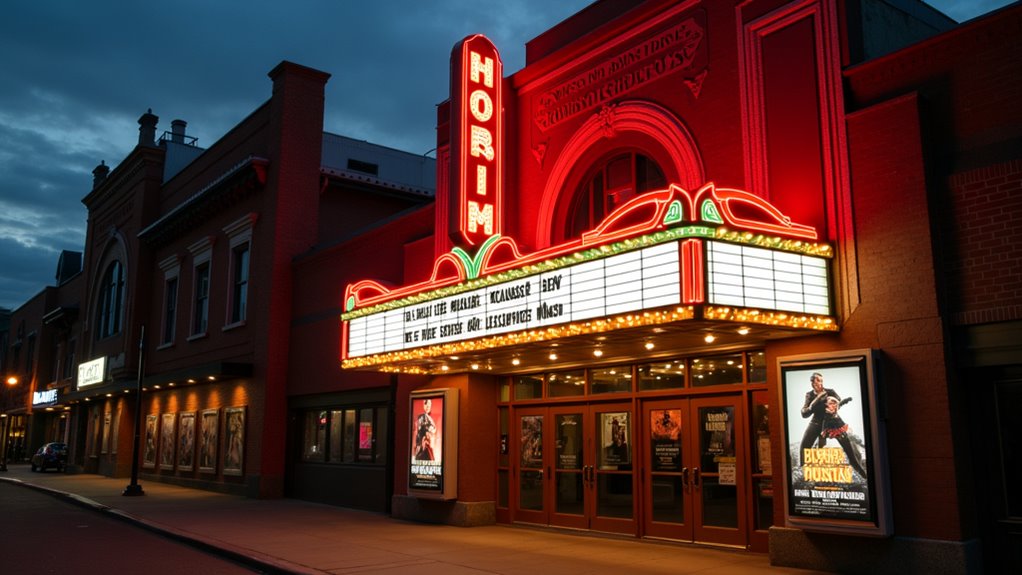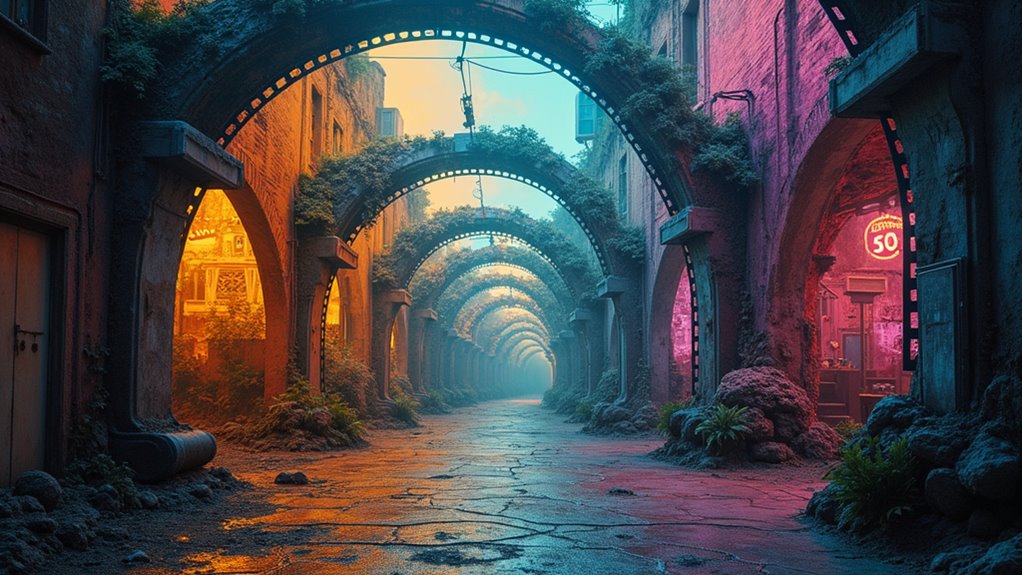Film genres have evolved dramatically since cinema’s inception, from early Westerns and slapstick comedies to today’s genre-bending masterpieces like “Inception” and “Parasite.” Modern filmmakers increasingly blend traditional categories, creating innovative hybrids that combine elements of horror, comedy, drama, and science fiction. While personal preferences vary, the rise of streaming platforms and global influences continues to reshape storytelling possibilities, with technological advances enabling previously unimaginable creative expressions. The endless combinations of genre elements offer fascinating new territory to explore.
The Evolution of Classic Film Genres Through Modern Cinema

While the earliest films emerged as mere technological novelties, the evolution of classic film genres through modern cinema represents one of the most fascinating transformations in artistic history. From the exaggerated gestures of silent films to today’s CGI spectacles, filmmakers have continuously pushed creative boundaries while adapting to technological advances. The silent era marked the beginning of enduring genres like Westerns and comedies. These early genres provided audiences with a shared language for understanding film narratives.
Cinema’s journey from simple novelties to artistic mastery shows how technology and creativity dance in perfect harmony.
The Golden Age of Hollywood established foundational genres like film noir and musicals, with classics such as “Double Indemnity” and “The Wizard of Oz” setting enduring standards. The Pioneer Era introduced the very first experimental films that would lay the groundwork for these sophisticated genres.
As the French New Wave challenged conventions in the 1960s, directors like Godard and Truffaut redefined storytelling possibilities. The blockbuster era then ushered in high-concept films and franchise phenomena, with “Star Wars” forever changing audience expectations.
Today’s digital revolution has birthed hybrid genres and reimagined classics, while streaming platforms provide unprecedented creative freedom. Modern superhero films, for instance, seamlessly blend action, drama, and sci-fi elements, proving that genre evolution remains as dynamic as ever.
How Genre-Blending Creates Unique Cinematic Experiences
The art of blending film genres represents one of cinema’s most powerful storytelling innovations. By expertly combining elements from different genres, filmmakers create unique narratives that transcend traditional categorization and captivate diverse audiences.
Films like Inception, which seamlessly merges mind-bending sci-fi with classic heist elements, demonstrate how genre-blending can elevate storytelling to new heights. Understanding core genre conventions helps screenwriters craft more effective and marketable genre-blending stories.
This creative approach offers filmmakers unprecedented opportunities to craft multifaceted experiences, as seen in movies like Parasite, where comedy, thriller, and social commentary coexist brilliantly. Modern audiences actively seek fresh viewing experiences beyond traditional single-genre films.
The rise of digital technologies has empowered independent filmmakers to experiment with genre-blending more freely than ever before.
From The Shape of Water’s romantic fantasy to Alien’s sci-fi horror fusion, successful genre-blending requires a delicate balance of conventions while pushing creative boundaries.
When executed skillfully, these hybrid films can evoke a wider range of emotions and reactions from viewers, keeping them engaged through unexpected narrative turns.
The result is a richer cinematic experience that appeals to broader audiences while maintaining artistic integrity and innovation.
The Impact of Technology and Global Influences on Film Categories

Modern technological breakthroughs have fundamentally reshaped film categories, blurring traditional genre boundaries and expanding creative possibilities beyond conventional storytelling limits.
The rise of digital cinematography and sophisticated CGI has enabled filmmakers to create previously unimaginable worlds, while AI tools are revolutionizing screenplay development and performance capture. Original programming investments reaching $10.5 billion annually demonstrate the industry’s commitment to pushing creative boundaries. AI-powered tools are now helping studios streamline production through advanced casting systems that match actors to roles based on specific criteria.
Streaming platforms have dramatically altered how audiences consume and interact with different genres, making international films more accessible and encouraging experimentation with hybrid storytelling formats.
Virtual reality and augmented reality technologies are pushing the boundaries further, transforming passive viewing into immersive experiences that challenge traditional genre classifications.
The global marketplace has also influenced genre evolution, as cultural cross-pollination leads to innovative blends like Korean horror-comedies and Bollywood sci-fi epics.
These technological advancements, combined with increased international collaboration, have created a dynamic environment where film categories constantly evolve, adapt, and merge to reflect our interconnected world.
Frequently Asked Questions
Which Film Genre Typically Has the Highest Box Office Returns?
Adventure films consistently dominate box office returns, commanding 25.16% market share and generating $66.78 billion in total earnings.
Their success stems from universal narratives, cutting-edge visual effects, and franchise potential, as evidenced by Marvel’s ongoing dominance.
While action films follow closely at 22.78%, adventure’s broader appeal and family-friendly nature make it the undisputed revenue champion of modern cinema.
How Do Different Cultures Interpret and Adapt Western Film Genres?
Different cultures adapt Western film genres by infusing local themes and historical contexts while maintaining core genre elements.
Italian Spaghetti Westerns emphasize moral ambiguity and stylized violence, while Latin American Zapata Westerns focus on revolution and social justice.
Asian interpretations, like Manchurian Westerns, blend frontier themes with regional historical narratives.
Bollywood adds musical elements, and European versions incorporate local folklore, demonstrating the genre’s remarkable adaptability across cultural boundaries.
What Makes Some Film Genres More Popular During Specific Historical Periods?
Film genres gain popularity during specific periods due to their reflection of societal conditions and cultural zeitgeist.
During the Great Depression, escapist musicals provided relief from economic hardship, while Cold War anxieties fueled science fiction’s rise in the 1950s.
Similarly, the cynicism of the 1970s sparked a surge in gritty crime dramas, and post-9/11 superhero films offered reassuring narratives of good triumphing over evil.
Can Watching Certain Film Genres Affect Viewers’ Psychological Well-Being?
Research demonstrates that film genres can significantly impact viewers’ psychological well-being through various mechanisms.
Comedies boost mood by triggering dopamine release and reducing stress hormones, while horror films provide cathartic release, helping viewers process real-world anxieties.
Drama genres foster emotional intelligence and empathy, and action films can temporarily alleviate depression by engaging reward centers in the brain through heightened stimulation and adventure-based narratives.
Why Do Some Film Genres Consistently Receive More Critical Acclaim?
Certain film genres consistently garner more critical acclaim due to their ability to explore complex human themes and emotions in depth.
Drama and historical films, in particular, tend to receive higher critical praise for their nuanced storytelling, layered character development, and social commentary.
Additionally, these genres often attract accomplished directors and actors who elevate the material through sophisticated techniques and compelling performances, while addressing universal themes that resonate with diverse audiences.
